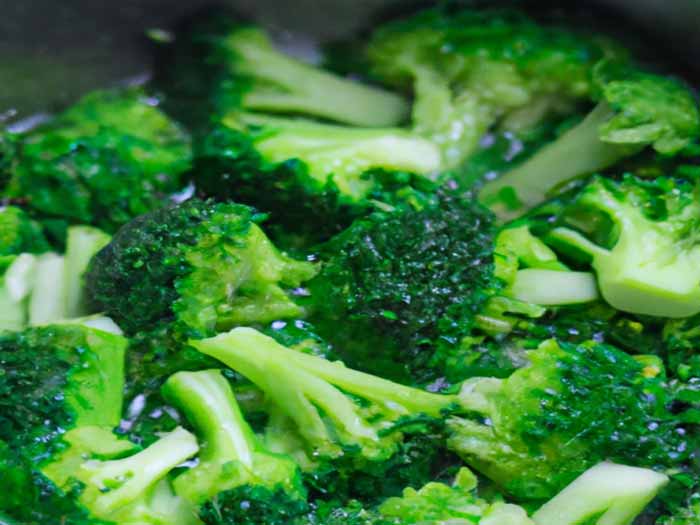Broccoli is a versatile and nutritious vegetable that can be enjoyed in various dishes. One of the simplest and most popular ways to cook broccoli is by boiling it. Boiling broccoli helps retain its vibrant color, preserves its nutrients, and results in a tender yet slightly crisp texture. In this comprehensive guide, we will walk you through the step-by-step process of boiling broccoli to perfection.
How To Boil Broccoli?
Step 1: Selecting and Preparing the Broccoli
To begin, choose fresh broccoli heads that are firm, with tightly closed florets and vibrant green color. Avoid any broccoli with yellowing florets or wilted leaves, as they indicate that the vegetable is not fresh. Once you have selected your broccoli, give it a thorough rinse under cold water to remove any dirt or debris.
Step 2: Preparing the Broccoli Florets
Next, prepare the broccoli by separating it into florets. Use a sharp knife to carefully cut off the stem, leaving about an inch or two attached to each floret. Then, using your hands or the knife, break or cut the larger florets into bite-sized pieces. This will ensure even cooking and help the broccoli cook more quickly.
Step 3: Boiling Water and Adding Salt
Fill a large pot with water, leaving enough room for the broccoli to be submerged. Place the pot on the stove over high heat and bring the water to a rolling boil. As the water heats up, add salt to taste. Salting the water will help enhance the flavor of the broccoli.
Step 4: Blanching the Broccoli
Once the water reaches a rolling boil, carefully add the prepared broccoli florets to the pot. Make sure the water completely covers the broccoli. Boil the broccoli uncovered for approximately 3-5 minutes, depending on the desired tenderness. Keep an eye on the broccoli and test it with a fork or a knife occasionally to avoid overcooking. You want the broccoli to be tender but still slightly crisp.
Step 5: Draining and Cooling
Once the broccoli reaches the desired level of tenderness, turn off the heat and carefully drain the water from the pot. You can use a colander or a slotted spoon to remove the broccoli from the pot while leaving behind the excess water. To preserve the vibrant green color and stop the cooking process, immediately transfer the boiled broccoli to a bowl filled with ice water. Let the broccoli sit in the ice water for a couple of minutes to cool down.
Step 6: Serving and Enjoying
After cooling, remove the broccoli from the ice water and let it drain thoroughly. Pat it gently with a paper towel to remove any excess moisture. Now your perfectly boiled broccoli is ready to be enjoyed! Serve it as a side dish, add it to salads, stir-fries, and pasta dishes, or use it as a nutritious topping for pizzas and sandwiches. Feel free to season the broccoli with a sprinkle of salt, pepper, or your favorite herbs and spices to enhance its flavor further.
What To Add To Broccoli To Make It Flavorful
Broccoli has a mild and slightly bitter taste on its own, but you can easily enhance its flavor by adding various ingredients. Here are some flavorful additions you can use to make your boiled broccoli more delicious:
Garlic
Sauté minced garlic in olive oil or butter until fragrant, then toss the boiled broccoli in the garlic-infused oil. The aromatic garlic will add a rich and savory flavor to the broccoli.
Lemon Juice
Squeeze fresh lemon juice over the boiled broccoli to add a bright and tangy flavor. The acidity of the lemon juice complements the earthy taste of broccoli and adds a refreshing twist.
Parmesan Cheese
Sprinkle-grated or shaved Parmesan cheese over the boiled broccoli. The nutty and salty flavors of Parmesan will complement the broccoli’s taste and create a delicious combination.
Soy Sauce
Drizzle a little soy sauce or tamari over the boiled broccoli for an umami kick. The soy sauce adds depth and savory flavor to the vegetable.
Balsamic Vinegar
Toss the boiled broccoli in a small amount of balsamic vinegar for a sweet and tangy flavor. The vinegar’s acidity and subtle sweetness can balance out the bitterness of the broccoli.
Red Pepper Flakes
Add a pinch of red pepper flakes to the boiled broccoli to give it a spicy kick. The heat from the pepper flakes can liven up the flavor profile of the vegetable.
Sesame Oil
Drizzle a small amount of toasted sesame oil over the boiled broccoli to give it an aromatic and nutty taste. Be mindful not to use too much, as sesame oil has a strong flavor.
Herbs and Spices
Experiment with herbs and spices to season your boiled broccoli. Try adding dried oregano, thyme, rosemary, or a sprinkle of your favorite spice blend to infuse the vegetable with additional flavors.
Remember, you can mix and match these additions to find your preferred flavor combination. Don’t be afraid to get creative and explore different seasonings that suit your taste preferences.
Other Ways To Cook Broccoli
While boiling is a popular method for cooking broccoli, there are several other ways to prepare this versatile vegetable. Here are some alternative cooking methods that can bring out different flavors and textures in broccoli:
Steaming
Steaming broccoli is a gentle cooking method that helps retain its nutrients and vibrant color. Place a steamer basket over a pot of boiling water, add the broccoli florets to the basket, cover, and steam for 5-7 minutes or until tender-crisp. Steamed broccoli pairs well with a drizzle of lemon juice, a sprinkle of salt, or a light dressing.
Roasting
Roasting broccoli can create a delicious caramelized flavor and a slightly crispy texture. Preheat your oven to 425°F (220°C). Toss the broccoli florets with olive oil, salt, and pepper, then spread them in a single layer on a baking sheet. Roast for 20-25 minutes, turning once halfway through, until the broccoli is tender and lightly browned. For added flavor, you can sprinkle grated Parmesan cheese, garlic powder, or lemon zest over the roasted broccoli.
Sautéing
Sautéing broccoli in a skillet with some oil or butter can create a quick and flavorful side dish. Heat oil or butter in a skillet over medium-high heat, add the broccoli florets, and cook for 5-7 minutes, stirring occasionally, until the broccoli is tender yet still crisp. You can add minced garlic, sliced onions, or red pepper flakes to the skillet for extra flavor.
Stir-Frying
Stir-frying is a fantastic way to cook broccoli quickly while maintaining its crunchiness. Heat some oil in a wok or skillet over high heat. Add the broccoli florets and stir-fry for 2-3 minutes, until they turn bright green and are crisp-tender. You can add other vegetables, such as bell peppers, carrots, or snap peas, and a splash of soy sauce or teriyaki sauce to create a flavorful stir-fry.
Grilling
Grilling broccoli adds a smoky and charred flavor to the vegetable. Preheat your grill to medium-high heat. Toss the broccoli florets with olive oil, salt, and pepper. Grill the broccoli for 4-6 minutes, turning occasionally, until it is slightly charred and tender. Grilled broccoli works well as a side dish or as part of a grilled vegetable medley.
These cooking methods offer different textures and flavors, allowing you to vary your broccoli dishes and keep things interesting. Feel free to experiment with different seasonings, sauces, or combinations of vegetables to create delicious meals with broccoli as the star ingredient.
How To Use Boiled Broccoli
Boiled broccoli can be used in a variety of dishes to add a nutritious and flavorful component. Here are some ideas on how to incorporate boiled broccoli into your meals:
Side Dish
Serve boiled broccoli as a simple and nutritious side dish. Season it with a sprinkle of salt, pepper, and a drizzle of olive oil or melted butter. It pairs well with roasted meats, grilled chicken, fish, or alongside a hearty main course.
Salads
Add boiled broccoli to salads for an extra burst of color, texture, and nutrients. Toss the cooled broccoli florets with mixed greens, cherry tomatoes, cucumber slices, and your favorite salad dressing. You can also combine it with other cooked vegetables, grains, or proteins to create a more substantial salad.
Pasta Dishes
Incorporate boiled broccoli into pasta dishes for a nutritious twist. Toss it with cooked pasta, olive oil, garlic, and grated Parmesan cheese for a simple and flavorful combination. You can also add boiled broccoli to creamy pasta dishes like fettuccine Alfredo or pasta primavera.
Stir-Fries
Use boiled broccoli in stir-fries for a quick and healthy meal. Heat a wok or skillet with some oil, add the boiled broccoli, and stir-fry it with other vegetables, such as bell peppers, carrots, and snap peas. Add a protein of your choice (like chicken, beef, tofu, or shrimp) and season with soy sauce, ginger, garlic, and other desired seasonings for a delicious stir-fry.
Soups and Stews
Blend boiled broccoli with other ingredients to create a creamy broccoli soup. Sauté onions, garlic, and boiled broccoli in a pot add vegetable or chicken broth, and simmer until the flavors meld together. Use an immersion blender or a countertop blender to puree the mixture until smooth. Season with salt, pepper, and herbs of your choice. You can also add boiled broccoli to vegetable or chicken stews to enhance the nutritional value and add a vibrant touch.
Casseroles and Quiches
Incorporate boiled broccoli into casseroles and quiches for a nutritious boost. Combine it with cooked rice, cheese, and other vegetables in a casserole dish. Alternatively, mix boiled broccoli with eggs, cheese, and other desired ingredients to make a flavorful broccoli quiche.
Pizza Topping
Use boiled broccoli as a topping for homemade or store-bought pizzas. Chop the boiled broccoli into small pieces and sprinkle it over your pizza dough along with other toppings like cheese, tomatoes, onions, and mushrooms. Bake the pizza according to the recipe or package instructions.
Frequently Asked Questions About How To Boil Broccoli
Can I freeze boiled broccoli?
Yes, you can freeze boiled broccoli for later use. After boiling the broccoli, drain it thoroughly and let it cool completely. Once cooled, transfer the broccoli to freezer-safe containers or freezer bags, removing as much air as possible. Label the containers with the date and store them in the freezer for up to 3-4 months. When you’re ready to use the frozen broccoli, thaw it in the refrigerator overnight before incorporating it into your desired recipe.
How long should I boil broccoli?
The boiling time for broccoli can vary depending on your desired level of tenderness. Generally, boiling broccoli for 3-5 minutes is sufficient to achieve a tender yet slightly crisp texture. However, it’s essential to monitor the cooking process and test the broccoli with a fork or knife for doneness. Overcooking can result in mushy broccoli, so it’s better to slightly undercook it if you prefer a crisper texture.
Does boiling broccoli remove its nutrients?
Boiling broccoli can cause a minimal loss of some nutrients, as they may leach into the cooking water. However, the impact is relatively small compared to other cooking methods like prolonged boiling or microwaving. To minimize nutrient loss, it’s recommended to use a minimal amount of water and avoid overcooking. Additionally, you can preserve the nutrient-rich cooking water and use it as a base for soups or sauces.
Can I reuse the water used for boiling broccoli?
Yes, you can reuse the water used for boiling broccoli. The water contains some of the nutrients from the broccoli, so you can save it and use it as a base for soups, stocks, or as a cooking liquid for grains like rice or quinoa. Ensure that the water is strained to remove any small broccoli pieces before using them in other recipes.
Can I use the broccoli stems in addition to the florets?
Absolutely! Broccoli stems are edible and can be used alongside the florets. To utilize the stems, peel off the tough outer skin with a vegetable peeler, revealing the tender inner part. You can slice or dice the stems and cook them along with the florets. They offer a slightly different texture and flavor but are equally nutritious and delicious.



